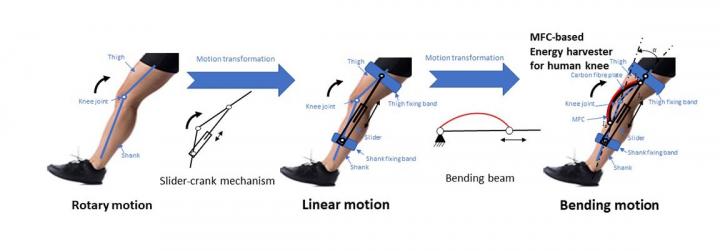Harvesting energy from the human knee

This is a diagram of the slider-crank mechanism that generates energy during the knee's motion. Credit: Gao et al.
Imagine powering your devices by walking. With technology recently developed by a group of researchers at the Chinese University of Hong Kong, that possibility might not be far out of reach.
The group describes the technology in Applied Physics Letters, from AIP Publishing. An energy harvester is attached to the wearer's knee and can generate 1.6 microwatts of power while the wearer walks without any increase in effort. The energy is enough to power small electronics like health monitoring equipment and GPS devices.
“Self-powered GPS devices will attract the attention of climbers and mountaineers,” said author Wei-Hsin Liao, professor in the department of mechanical and automation engineering.
The researchers used a special smart macrofiber material, which generates energy from any sort of bending it experiences, to create a slider-crank mechanism — similar to what drives a motor. The authors chose to attach the device to the knee due to the knee joint's large range of motion, compared to most other human joints.
“These harvesters can harvest energy directly from large deformations,” Liao said.
Due to the continuous back-and-forth the material will encounter when the wearer walks, every time the knee flexes, the device bends and generates electricity. This means the harvester can “capture biomechanical energy through the natural motion of the human knee,” according to Liao.
Previous wearable energy harvesters took advantage of the vibration caused in the device as a result of motion, which comes with drawbacks regarding efficiency.
“The frequency of human walking is quite slow, which significantly decreases the energy-harvesting capability,” Liao said. Because the group's device uses a different method, it bypasses this limitation.
The prototype weighs only 307 grams (0.68 pounds) and was tested on human subjects walking at speeds from 2 to 6.5 kilometers per hour (about 1 to 4 miles per hour). The researchers compared the wearers' breathing patterns with and without the device and determined that the energy required to walk was unchanged, meaning that the device is generating power at no cost to the human.
The researchers note the advantages of an efficient, wearable energy harvester and look towards future commercialization of the technology.
“Self-powered equipment can enable users to get rid of the inconvenient daily charge,” Liao said. “This energy harvester would promote the development of self-powered wearable devices.”
###
The article, “Macro fiber composite-based energy harvester for human knee,” is authored by Fei Gao, Gaoyu Liu, Brendon Lik Hang Chung, Hugo H. Chan and Wei-Hsin Liao. The article appeared in Applied Physics Letters on July 16, 2019 (DOI: 10.1063/1.5098962) and can be accessed at http://aip.
ABOUT THE JOURNAL
Applied Physics Letters features concise, rapid reports on significant new findings in applied physics. The journal covers new experimental and theoretical research on applications of physics phenomena related to all branches of science, engineering, and modern technology. See http://apl.
Media Contact
More Information:
http://dx.doi.org/10.1063/1.5098962All latest news from the category: Physics and Astronomy
This area deals with the fundamental laws and building blocks of nature and how they interact, the properties and the behavior of matter, and research into space and time and their structures.
innovations-report provides in-depth reports and articles on subjects such as astrophysics, laser technologies, nuclear, quantum, particle and solid-state physics, nanotechnologies, planetary research and findings (Mars, Venus) and developments related to the Hubble Telescope.
Newest articles

NASA: Mystery of life’s handedness deepens
The mystery of why life uses molecules with specific orientations has deepened with a NASA-funded discovery that RNA — a key molecule thought to have potentially held the instructions for…

What are the effects of historic lithium mining on water quality?
Study reveals low levels of common contaminants but high levels of other elements in waters associated with an abandoned lithium mine. Lithium ore and mining waste from a historic lithium…

Quantum-inspired design boosts efficiency of heat-to-electricity conversion
Rice engineers take unconventional route to improving thermophotovoltaic systems. Researchers at Rice University have found a new way to improve a key element of thermophotovoltaic (TPV) systems, which convert heat…



